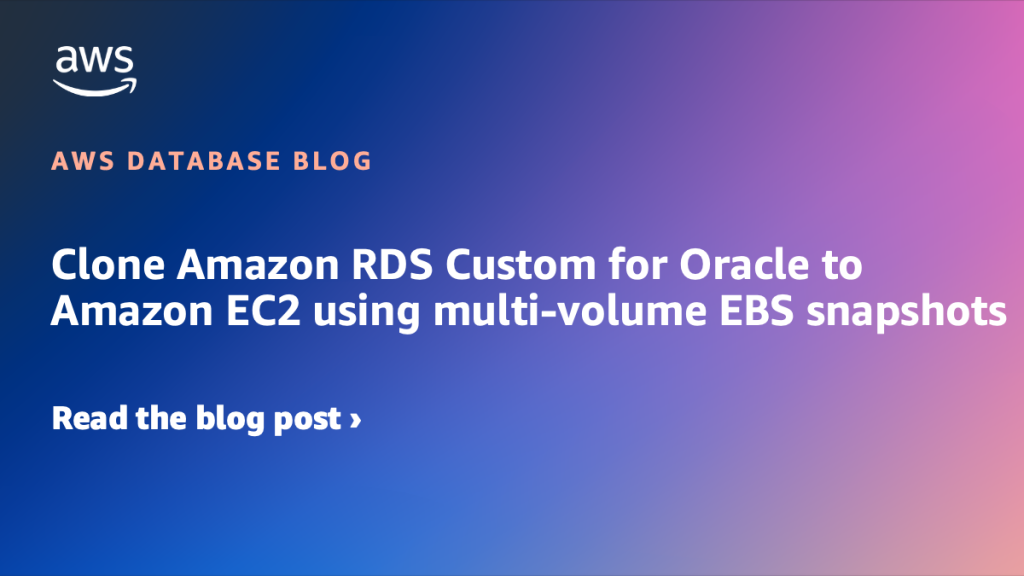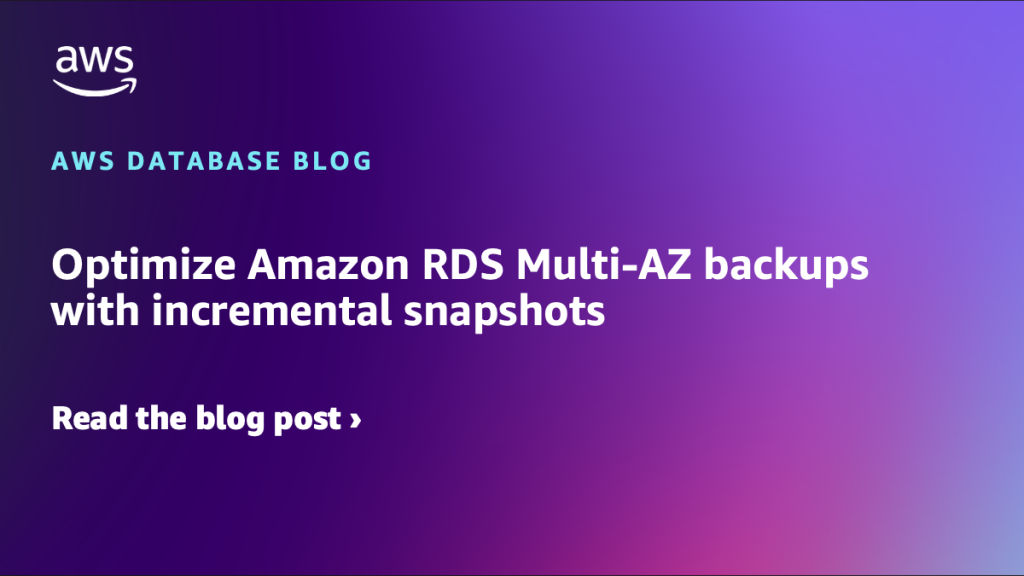AWS Database Blog
Category: Amazon Elastic Block Store (Amazon EBS)
Clone Amazon RDS Custom for Oracle to Amazon EC2 using multi-volume EBS snapshots
In this post, we walk you through the process of cloning an Amazon RDS Custom for Oracle database to an EC2 instance using multi-volume Amazon Elastic Block Store (Amazon EBS) snapshots for storage replication. This approach is useful for setting up a disaster recovery (DR) environment in a Region where RDS Custom is not yet available.
Optimize Amazon RDS Multi-AZ backups with incremental snapshots
As your business grows and your databases expand into the terabyte range, optimizing your backup strategy becomes increasingly important for maintaining operational excellence. Modern backup solutions that implement incremental backups where possible, offer an elegant way to protect your valuable data while minimizing maintenance windows and ensuring consistent application performance. In this post, we discuss the aspects of maximizing the use of incremental backups in Amazon RDS, leading to backup times remaining steady even while the database grows.
Optimize Amazon RDS performance with io2 Block Express storage for production workloads
Choosing the right storage configuration that meets performance requirements is a common challenge when creating and managing database instances. In this post, we provide an end-to-end guide for what storage class to choose depending on your use case. In addition, we compare the performance of different storage volumes on open source engines supported by Amazon RDS, to validate them from a database-centric perspective.
Shrink storage volumes for your RDS databases and optimize your infrastructure costs
Recently, Amazon RDS launched the ability to shrink storage volumes using Amazon RDS Blue/Green Deployments – a nice addition to the list of new use cases that Blue/Green Deployments now supports. In this post, we cover how to use the new storage volume shrink feature in Amazon RDS Blue/Green Deployments to minimize the downtime required to perform the storage size reduction operation. We also review various mechanisms to monitor the progress of storage shrink and best practices on how to arrive at the optimal storage size for your shrink storage task.
Best practices for Amazon RDS for SQL Server with Amazon EBS io2 Block Express volumes up to 64 TiB
Amazon RDS for SQL Server now supports Amazon EBS io2 Block Express volumes. These volumes are designed to support all your critical database workloads that demand high performance, high throughput, and consistently low latency. io2 Block Express volumes support 99.999% durability, up to 64 TiB storage, up to 4,000 MiB/s throughput, and up to 256,000 Provisioned IOPS for your most demanding database needs, at the same price as EBS io1 volumes. In this post, we share best practices to use the io2 Block Express volumes with RDS for SQL Server DB instances.
Run an Ethereum staking service on Amazon EKS
In September 2022, Ethereum transitioned to a Proof of Stake (PoS) consensus model. This change allows anyone with a minimum of 32 ether to stake their holdings and operate a validator node, thereby participating in network validation and earning staking rewards. In this post, we explore the technical challenges and requirements of operating an institutional-grade Ethereum staking service. Additionally, we outline a solution for deploying an Ethereum staking service on AWS.
Enhance database performance with Amazon RDS dedicated log volumes
For those seeking to achieve consistent database transaction performance, Amazon RDS has introduced a new feature: dedicated log volume (DLV). This feature is an additional storage volume specifically for database transaction logs. In this post, we examine common DLV performance benefits, use cases, monitoring capabilities, and the cost of deployment.
Improving Oracle backup and recovery performance with Amazon EBS multi-volume crash-consistent snapshots
Amazon Elastic Block Store (EBS) snapshots offer the ability to back up the data on your EBS volumes to Amazon S3 by taking point-in-time snapshots. If you run your Oracle Databases on Amazon EC2 and use EBS volumes, you may be using EBS snapshots to meet your backup requirements. Prior to May 2019, you had […]
Using Amazon EBS elastic volumes with Oracle databases (part 3): databases using Oracle ASM
October 2024: This post was reviewed for accuracy. In parts 1 and 2 of this blog series, we discuss the elastic volumes feature for Amazon EBS and how it works with Oracle database storage layouts. We discuss elastic volumes with databases that use operating-system file systems and that use Logical Volume Managers (LVM) for database […]
Using Amazon EBS elastic volumes with Oracle databases (part 2): databases using LVM
August, 2024: This post has been reviewed and updated for accuracy. In part 1 of this blog series, we discuss the elastic volumes feature. We also discuss Oracle database storage layouts for simple databases that use a single Amazon EBS volume without LVM for database storage. In this post, part 2 of the series, we […]









